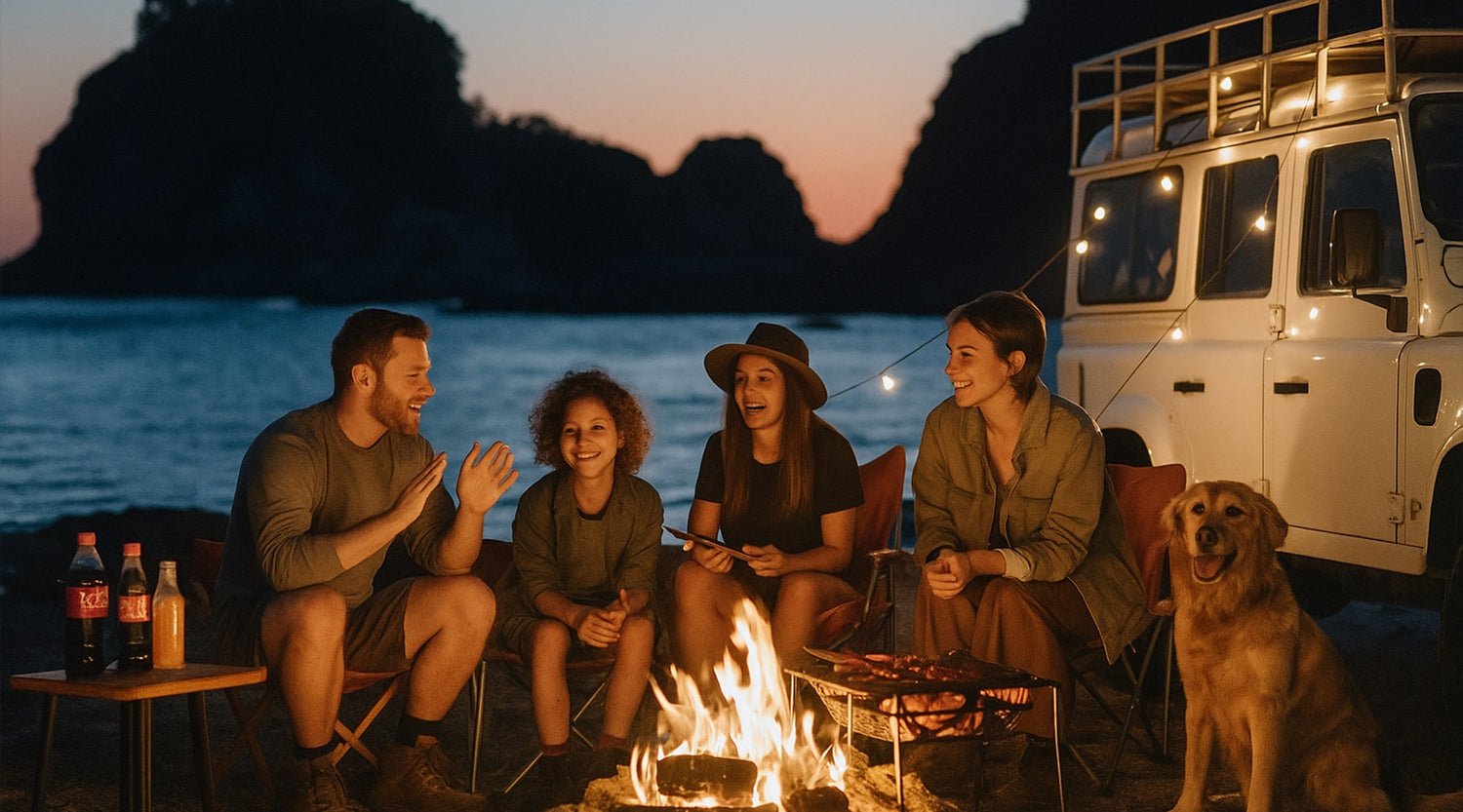Love spending time outside? Picnics, camping, festivals – they’re all great ways to enjoy yourself. However, as temperatures climb, the relentless heat can become an unwelcome intruder, turning joyful outings into a battle against discomfort and fatigue. If this sounds familiar, you'll be interested in cooling blankets. These specially designed blankets offer a straightforward way to stay more comfortable and enjoy your outdoor time longer. This guide will walk you through what they are, how they help, and what to look for when picking one out.
What Are Cooling Blankets?
Cooling blankets are quite different from the ones you use to keep warm. Their main job is to help manage heat, either by pulling warmth away from your body or by creating a noticeable cooling sensation. They achieve this through a few common methods and materials:
Breathable and Moisture-Wicking Fabrics:
Many cooling blankets use materials like bamboo, Tencel (a type of rayon), specially developed polyester or nylon blends, or crisp cotton percale. These fabrics are champions of airflow. They also pull sweat away from your skin, and as that moisture evaporates, it cools you down. This is a big help in feeling less sticky and more comfortable in the heat.
Heat-Conductive Yarns or Fibers:
Some blankets have yarns or fibers woven into them that contain materials like jade particles or mica. These materials are naturally good at conducting heat. They work by drawing warmth from your body and spreading it out through the fabric, which makes the blanket feel cool when you touch it.
Phase Change Materials (PCMs):
This technology is a bit more complex. PCMs are substances that absorb a good amount of heat when they change from a solid to a liquid state (and release it when they go back to solid). Blankets with PCMs can maintain a cooler temperature for a while. It's worth noting that these often need a "recharge" period—usually by being placed in a cooler environment—to work again effectively.
Evaporative Cooling (Less Common for Blankets):
You might be more familiar with this principle from cooling towels. Some lightweight blankets use it too. The idea is that water held in the fabric evaporates, and this process draws heat away from whatever the fabric is touching, including you. These blankets need to be damp to work.
The key difference from your regular blankets, which are made to trap heat and keep you warm, is that cooling blankets are all about releasing heat and helping you feel cooler.
Common Outdoor Activities and How Cooling Blankets Help
Heat can show up as an unwelcome guest in many outdoor situations. Here’s where a cooling blanket can make a real difference:
Picnics and Relaxing in the Park:
The ground can get surprisingly hot, especially under direct sun. Spreading out a cooling blanket gives you a noticeably cooler and more comfortable surface to sit or lie on, making your picnic or park hangout significantly more pleasant t and allowing you to linger longer without discomfort. Imagine enjoying your sandwiches and conversation without constantly shifting to avoid a hot patch of grass..
Beach Days:
Hot sand is a classic beach complaint, feeling like walking on hot coals, and the sun can be intense reflecting off the water and sand. A cooling blanket offers a welcome barrier from the scorching sand and provides a cleaner, cooler spot to relax between dips in the refreshing water. It's your personal oasis of cool amidst the sun-baked shoreline.
Camping and Backpacking:
Tents can get stuffy and warm, particularly in the summer, making sleep difficult and leaving you feeling groggy. A lightweight, packable cooling blanket can be a great addition to your camping gear. It can help regulate your body temperature for a more restful night, which is especially important if you've been hiking all day under a heavy pack. After a long trek, draping a cooling blanket over your shoulders or legs can also be a quick way to cool down and soothe tired muscles.
Sporting Events, Concerts, and Festivals:
Sitting or standing for long periods in sunny, crowded places like stadiums or festival grounds can get very warm. Hot seats, often made of heat-absorbing plastic or metal, don't help either. A personal cooling blanket can make these experiences much more comfortable, allowing you to focus on the event instead of the sweltering heat. Think of it as your portable air-conditioned seat.
Travel (Road Trips, Outdoor Markets):
Think about how hot car seats can get after the car has been parked in the sun, making that initial sit-down almost unbearable. Or, when you're at an outdoor market, navigating bustling crowds and sunny stalls, and just need a spot to cool down for a few minutes. A cooling blanket is easy to bring along and can offer quick relief, transforming a scorching car seat or a random bench into a comfortable resting spot.
Key Benefits of Using Cooling Blankets Outdoors
Having looked at where they can be used, the advantages of incorporating a cooling blanket into your outdoor kit become clearer:
Stay Comfortable for Hours Longer Outdoors
The most immediate benefit is a cooler surface to sit or lie on. This can significantly cut down on that sticky, sweaty feeling, allowing you to stay out and enjoy yourself for longer stretches.
Enjoy Deeper, More Restorative Sleep While Camping
As mentioned with camping, helping to keep your body temperature more stable in a warm tent can lead to deeper, more restorative sleep. This is crucial if you have several days of activity planned.
Recover Faster After Physical Activities
After exercising, whether it's a hike, a game of beach volleyball, or just running around with the kids, a cooling blanket can provide a refreshing way to help bring your core body temperature down more quickly. This can aid in muscle recovery and reduce overall heat stress on your system..
Save Space With Lightweight, Multi-Purpose Gear
Most cooling blankets designed for outdoor use are lightweight and pack down small. This makes them easy to toss in a bag. They aren’t just for sitting on either; you can use them as a light wrap or even as an extra layer inside a tent.
Create a Cooling Zone for Heat-Sensitive Family Members
They can create a small area of coolness that’s especially helpful for children or anyone who is more sensitive to heat.
Shield Yourself from Scorching Surfaces
This is a simple but valuable benefit – a cooling blanket acts as a barrier between you and things like hot sand, sun-baked park benches, or scorching car seats.
Choosing the Right Cooling Blanket for Outdoor Use
With different types available, it's useful to think about what features will best suit your needs. Here are the key factors to consider:
Match the Cooling Technology to Your Climate:
For moderately warm conditions, choose breathable, moisture-wicking fabrics like bamboo or Tencel. For a noticeably cool feeling, select blankets with heat-conductive yarns containing jade or mica. In extremely hot environments, opt for Phase Change Materials that provide intense cooling, but note their recharge requirements. Consider evaporative cooling options only if you don't mind them being damp.
Consider the Activities When Selecting Size:
Choose compact, lightweight blanket options (under 1 lb) for backpacking or hiking when space is limited. For family picnics or beach days, select larger blankets that accommodate multiple people. Always check packed dimensions if portability is important for your intended use.
Inspect Construction Quality for Outdoor Durability:
Look for reinforced edges and strong stitching that withstand outdoor conditions. Choose blankets with snag-resistant fabrics and sand/dirt-resistant properties. Avoid delicate materials that can tear easily when used on rough ground.
Prioritize Easy-Clean Options for Regular Use:
Select machine-washable blankets for convenient maintenance after outdoor adventures. Check care labels for special washing instructions before purchasing. Consider quick-drying materials if you'll need to reuse the blanket during multi-day trips.
Improve Your Outdoor Comfort with Cooling Blankets!
Uncomfortable heat doesn't have to spoil your time outdoors. Cooling blankets offer a practical way to manage warmth, whether you're at a campsite, a park, or the beach. By providing a cooler, more comfortable space, they can help you and your family enjoy your activities for longer. Investing in one can lead to many more pleasant hours spent in the fresh air.




Dejar un comentario
Este sitio está protegido por hCaptcha y se aplican la Política de privacidad de hCaptcha y los Términos del servicio.